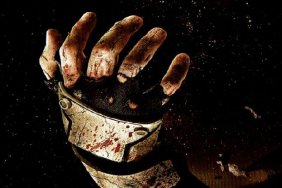Growing up, I heard nothing but great things about Castlevania. Be it the classic GBA entries, their exemplary DS follow-ups, or even the original Lords of Shadow. I was forever swimming in a sea of praise for Konami’s vampire-centric action-adventures. With the impressive success of the first Lords of Shadow, developer MercurySteam seemed on the brink of truly cracking 3D Castlevania, and with some of the 2D titles recently under my belt, LoS2 looked to be the perfect 3D-vania entry point. Much to my dismay, Lords of Shadow 2 is a far cry from action-game greatness, and though not without redeeming traits, it’s near impossible to love without fond memories of its predecessor to pad the experience.
The issues with Lords of Shadow 2 run deep, but it’s not for a lack of trying–the entire game is admirably ambitious. Gabriel Belmont returns as protagonist from the previous LoS (now stepping into Dracula’s capacious leather-bound shoes), and the results of such a clever premise are surprisingly ordinary. Your old colleague Zobek is among the first of familiar faces to reappear, and despite his new look (he now dons a suit-and-cigar, movie producer getup), he’ll assist you in similar ways. He’s not just suited up for kicks, in case you missed it–Castlevania’s story has officially been dragged into the modern age.
Upon waking and reuniting with big Z, Dracula is offered a family of mortals to feast on to regain his strength, and this is around where I started getting an uneasy feeling. Lords of Shadow 2 clearly aims to offer a unique experience in that the player controls a traditionally villainous character, and at first it almost works. Despite Zobek arranging the whole thing, Gabriel’s banquet of innocent blood effectively jars the player into an awesome realization–you really are playing as Dracula. Though the sequence itself is a bit mawkish, it does its job.
The problem, and one that MercurySteam either failed to anticipate or decided mid-development was no longer important, is that despite early thrills as a result of being evil, it eventually becomes apparent that the Gabriel/Dracula hybrid is no less a protagonist than anything the average gamer is accustomed to. I found this pretty disappointing. Sure, Dracula is “evil” enough to feast on innocents, but the reality is that he’s still hunting down minions of Satan to stop the catastrophic resurrection of an ultimate malevolent force. Overwrought explanations aside, you’re really just saving the world. Talk about a yawner.

Luckily, the world in question is quite the prodigious one, and though not executed perfectly, it’s good enough to justify open-world as the right move for the series. I found Dracula’s castle to be the most interesting to explore, but the modern-day city that’s sprung up around it proves to be equally as expansive. Perhaps unsurprisingly, it fails to feel as truly massive as some of the 2D entries (think Metroid Fusion if you haven’t played them), but it is a step in the right direction.
Perhaps the world’s most obvious flaw is a lack of enough interesting or logical areas in the environment. The city is riddled with seemingly pointless dead-ends, and despite being technically “open,” it can sometimes feel like a series of linear segments that have been daisy-chained together. This isn’t bad by default (Lightning Returns’ city of Luxerion executes this style of openness brilliantly), but it does require care and attention to detail that is simply lacking in Lords of Shadow 2. The effort is there, but the desired effect is far too infrequent.
The game’s saving grace is probably its combat, but given that it’s not exceedingly innovative against other action games with better story, it’s questionable whether you’ll ultimately care. What I enjoyed most was switching between Dracula’s three weapon options. His whip acts as a trusty go-to, while the Void Sword and Chaos Claw both serve different fighting styles and strategies. The former is relatively weak, but heals the user with each strike, while the latter packs a serious wallop and can be used to bash through shields and other defenses. It’s certainly a clever scheme, and I enjoyed developing what I assume is a somewhat unique play style by obsessively keeping my HP high, but once you establish your strategy you’ll be unlikely to deviate from it. You may need to retool for a boss or two, but otherwise, it can get a tad repetitive.

Unfortunately, combat and unrealized good ideas are where the game’s strengths abruptly end. For all the comparisons to Zelda leading up to release, Lords of Shadow 2’s puzzles are frustratingly unimaginative. There are inoffensive platforming sections that spice up pacing but little else, while stealth segments that make absolutely zero sense plague the entire experience by rendering you powerless against theoretically defeatable enemies. When you consider that much of the game consists of killing everyone and everything in an area to advance, suddenly and inexplicably resorting to stealth is a sour grape to swallow.
At times while playing Castlevania: Lords of Shadow 2, I felt an odd and unusual sensation, similar but different to something I feel while playing great games. I think it’s because Lords of Shadow 2, for all intents and purposes, should have been great. Its predecessor was well regarded and concluded with tons of momentum; almost everything about the follow-up’s production value suggests a continuation of that trend. Sadly, when you sit down to actually play, the smart but overwrought story and forced implementation of far too many gameplay types renders the entire quest oft-pretty but all-too-frustrating. Castlevania junkies will want to know how Gabriel’s story unfolds, but otherwise, you may want to hold out for the bargain bin on this one.

Griffin Vacheron is a Writer for CraveOnline. You can follow him on Twitter @novacav.
PS3 copy provided by publisher. Game is available on PC, PS3, and Xbox 360.







